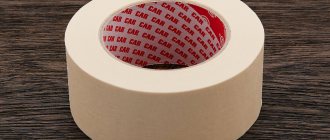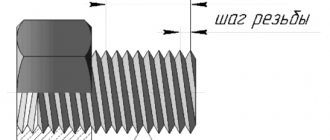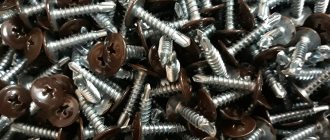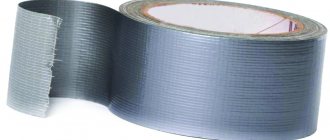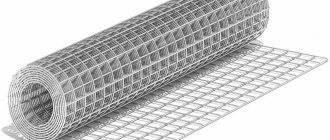Masking tape is a real salvation for construction and painting work. With its help, perfectly straight lines are created on all surfaces, it is resistant to chemicals and temperature changes, and can be removed from the treated areas carefully and without residue. Paper tape is used in many areas, is easy to use, and has a large number of varieties.
Masking tape - what is it and what is it for?
Masking tape is a product with an adhesive surface, its base is rough paper. It consists of two sides: on one of them there is rubber glue, on the second there is a layer of paper that absorbs all liquids or paint (corrugated is the base). The product has many positive characteristics: high elasticity, good gluing ability, ease of operation. Masking tape is easily removed and is used in conditions with high humidity. Let's look at what masking tape looks like: it's a roll of tape that can be painted in different colors, different widths and thicknesses.
The product has many positive characteristics: high elasticity, good gluing ability, ease of operation.
Areas of use
Modern paper-based masking tape has many useful features. First of all, it protects the fabric of walls, ceilings, mirrors and tiles during paint application procedures. This is convenient for decorative painting - the crepe is glued to the desired areas, and paint is applied on top. When the tape is removed, perfectly even geometric shapes remain. In construction, if it is necessary to make holes of different depths, masking paper tape is used as a limiter. The product is wound onto a drill or drill, limiting further drilling.
For decorative painting, the crepe is glued to the desired areas, and paint is applied on top. When the tape is removed, perfectly even geometric shapes remain.
It is convenient when measuring a large area with a measuring tape to attach its edge with a crepe. Painting tape 10 mm allows you to carefully and beautifully make markings: when gluing wallpaper, painting, on tiles, glass, dark and light surfaces. If glass breaks, simply use adhesive to pick up the pieces. During repair and construction work, a small life hack is used: put bolts, plugs, nuts on the tape - everything will be at your fingertips when installing at height or at home. Masking adhesive paper tape is applied around the perimeter of the entrance or interior door, protecting the door leaf and frame from the mounting foam.
To avoid staining the floor with construction waste, make an envelope from a sheet of paper and attach it using 10 mm wide construction tape to the wall. This design will collect all the dust and dirt, leaving the parquet clean. Small, lightweight tools and parts after repairs can be fastened together using tape. It is convenient to glue film or cardboard, joint to joint, and seal windows. The use of masking tape extends to almost all areas of life of a modern person.
It is convenient to glue film or cardboard, joint to joint, and seal windows.
If you need to glue parts of the packaging together, buy yellow or brown wide masking adhesive tape. Blue crepe is relevant in warehouses, for marking containers and products, at post offices or industrial production. The brown shade is ideal for camouflage and is resistant to sudden changes in humidity and temperature.
Types by color
The following colors are available for different areas of application:
- Yellow, white – regular masking tape for gluing surfaces before painting.
- Blue - waterproof tape with latex coating for facade work during temperature and humidity changes.
- Green – heat-resistant for work at temperatures up to 80 degrees, has a better adhesive composition.
- Pink, purple - for delicate surfaces, such as plaster, wallpaper, freshly painted walls.
Always check the area of application of the masking tape, and do not rely only on its color.
Necessary properties of masking tape
For comparison with other types of adhesive tape, the painting type with a paper base is distinguished by its individual properties. The product has many advantages:
- Large selection of sizes: there is 10 mm masking tape, thinner or thicker, different widths;
- Little weight;
- Relatively low price;
- High adhesion;
- Excellent strength – the tape is resistant to edge-type tears;
- Wide range of temperature conditions (from minus 10 to + 125 degrees Celsius);
- Resistance to changes in humidity and high frosts.
The tape can be combined with different types of paint products, parts, and components. It is simply and easily removed, the sticky residue is quickly wiped off from any surface. Good elasticity, can be used in any conditions.
The masking tape is simply and easily removed, the sticky mark is quickly wiped off from any surface.
Areas of use
The properties of crepe tape, such as strength, rapid absorption of moisture, lightness and low price, allow it to be used in a variety of construction and painting works. Scotch tape is suitable for any surface: from walls to ceilings, from plastic to concrete.
Painting crepe is indispensable in the following types of work:
These are the main ways to use masking tape. But there were other ideas to make repairs and housekeeping easier:
Rules for using masking tape (crepe)
The product is applied only to a previously dried, degreased and clean surface. Be sure to take into account the air temperature - it should be positive, ideally room temperature.
Note! Construction tape must be removed after the time indicated on the package. Sometimes this is immediately after the end of the work process. Rubber adhesive bonds quickly and increases adhesion. After a while, it will not be possible to carefully remove the product.
The product is applied only to a previously dried, degreased and clean surface.
Instead of an epilogue
Scotch tape has long and firmly entered into human life as one of the solutions to many problems. But it is always necessary to remember that depending on the task, it is necessary to select a certain type of material. But regarding the quality of the samples present on the Russian market, we can say the following: it is not very often that you come across frankly low-quality adhesive materials, because the technology for making adhesive tape is quite simple and it is difficult to spoil anything in it. However, very cheap samples should not be used, especially when some very exaggerated qualities are declared for them (for example, the level of adhesion).
How to choose masking tape
We have already figured out what masking tape is, now we need to understand how to choose the right material. Consider the possibility of gluing dusty and dirty surfaces, quick removal after a long time. Check the thin masking tape and its quality: move the strip (no more than 4 cm), then press the same area firmly back and pull again. If you need to use effort when peeling it off again, feel free to buy a skein. Material that peels off easily is of poor quality.
Of course, it is not always possible to check 1 cm masking tape this way. Pay attention to the thickness of the ribbon. A suitable option is thickness parameters of 125, 135 or 140 microns. You can find such a product in construction stores and car repair shops. Shades of strong ribbons: brown, white, yellow. Painting tape 5 mm wide glues well and firmly secures all objects. The main criterion is high adhesion. Pay attention to how many meters there are in the masking tape - this determines how long it will last you.
Consider the possibility of gluing dusty and dirty surfaces, quick removal after a long time.
Types of material
Most often, the basis of masking tape is paper. This is due to the fact that this type of adhesive tape is used for temporary fastening and for protecting edges. is used : it is much denser and is not saturated with adhesive.
They produce several different options.
- Scotch tape for clear lines - budget and super tape. The basis of the first is plain paper, the second is thin Japanese paper, as thick as tissue paper. This tape is extremely light and outlines any, even curved, contours. The tape is very easy to remove from the surface. It does not leave marks on plastic, wood, stone, paper wallpaper.
- For delicate surfaces – has a low level of adhesion. It is loosely attached and comes off very easily. The base is plain paper, but thin. It can be glued to wallpaper, even thin silk, the tape does not leave any traces.
- Radial – option with increased elasticity. It does not curl or form creases when creating curly lines with smooth, complex contours. This type of reinforcement does not break during transverse bending. Used for decorative purposes.
For delicate surfaces
For clear lines
Radial - Heat-resistant - used in areas where hot drying is required, for example, when painting a car body. Heat-resistant crepe can withstand temperatures of +110–+150°C for 1 hour. The usual one only works at +60°C.
- Moisture-resistant - or even waterproof, used for sealing window seams. It attaches quite firmly to the plastic. However, it is not difficult to remove: just warm it up a little with a hairdryer.
- UV resistant – masking tape for windows, intended for external work. It is resistant to sunlight and frost, as well as to dampness and contact with water - during rain or snowfall.
UV resistant
Waterproof
Heat resistant - Adhesive tape for long-term use - used in cases where it is necessary to connect slabs and sheets or cover seams for a long time - up to 30 or even 60 days. Typically, crepes are placed on durable, smooth surfaces - stone, brick, metal, hard plastic. But there are also options for delicate surfaces. This tape does not leave marks on drywall, for example, if used for 14-24 days.
- Double-sided - can have either a crepe or fabric base. The glue is applied on both sides. They connect surface parts together. The fastener is reliable and durable.
- Camouflage – a special variety used for masking rubber seals and gaskets for headlights, car windows, and moldings.
Camouflage
Double sided
Durable
There are also types of tape without an adhesive surface at all.
Criterias of choice
The choice directly depends on the purpose.
To select the right option, take into account the following parameters .
- Color - sometimes it doesn't mean anything. However, there are a number of manufacturers who use color as a marking, so you need to pay attention to this parameter. Regular tape is marked yellow, waterproof tape is blue, and adhesive tape that can withstand temperatures up to +80°C is green.
- Width and length – the width is determined by the nature of the work, and the length by the volume. The standard length per roll is 50 m, but this may not be enough.
- Thickness – determines the amount of tensile strength.
- Amount of adhesion – for delicate surfaces and decorative work, use thin tape with a low level of adhesion. And to seal the seams in the window frame, you need a durable material.
Other features are also taken into account: ultraviolet resistance, temperature range, if this is important.
How to remove traces after deletion
If you used 100mm wide masking tape, you need to know how to remove the remaining rubber adhesive. One effective way is to use simple office adhesive tape. The method works well with plastic items. Attach the material in place of the old one, press firmly. Tear it off with quick jerks several times. This is a soft effect on the plane, so it is impossible to damage or scratch the object.
One effective way to remove glue residue is to use simple office adhesive tape.
Second method: using a solution of baking soda and water. The mass should look like sour cream; the remaining glue is coated with it. You need to wait about 5 minutes, wipe off the composition with a cloth soaked in plenty of water. If necessary, the procedure is repeated. The residue is perfectly wiped off with products containing alcohol: pure ethanol, vodka, aftershave lotions. The latter must be selected without color so that it does not stain the area of application. The principle of operation is simple: a cloth or sponge is moistened in the substance, and the glue is wiped off with careful movements.
The mass should look like sour cream; the remaining glue is coated with it.
Masking tape is a material that leaves sticky marks that eat into plastic well. Plastic products do not tolerate contact with ethyl very well - be careful when cleaning with such compounds. Often deformation or change in shade occurs.
Simple medical alcohol is ideal for such purposes. After wiping the surface, wash it gently with household detergent.
Simple medical alcohol is ideal for such purposes.
It is recommended to use non-abrasive cleaning components. Gel, powder, liquid are allowed. Select a composition with microscopic crystals that cannot scratch the treated areas and act gently. A dishwashing sponge is slightly moistened with the mixture and the necessary areas are wiped. Rubbing is allowed only in particularly difficult places. A spray that works well for cleaning window glass. Simply spray it on and then rinse with clean water at room temperature.
A spray that works well for cleaning window glass.
If possible, use white spirit and gasoline, but remember - there should not be any impurities, because the coating can easily be damaged. In addition, chemical fumes have a negative impact on health. Test on a separate area to check the reaction. If after 10 - 15 minutes the shade and shape of the object has changed, you cannot continue working with liquids.
The situation is the same with acetone - it is a caustic substance that can damage the integrity of a layer of paint or varnish. Suitable for this work are napkins soaked in nail polish remover. To completely eliminate the risk of mechanical and chemical damage, take a composition without acetone.
Suitable for this work are napkins soaked in nail polish remover.
If the item is made of a material that can withstand hot air flows and temperatures, treat the area with a hairdryer or fabric steamer. Heat the tape, pull and it will easily come off completely. Do the same with the remaining adhesive - heat it up and remove it with a slightly damp cloth or microfiber. Steam exposure is an effective method. To do this, it is not necessary to use professional equipment - just breathe on the remaining substance and wipe it off.
If the item is made of a material that can withstand hot air flows and temperatures, treat the area with a hairdryer or fabric steamer.
Experts resort to another proven method - scrub the glue with oil (vegetable, olive). Painting tape 50 is generously moistened with oil, left for 15 - 20 minutes, then carefully peeled off. After this, the mark can be removed very simply with a dishwashing sponge. Next, the area is washed with water and detergent so that no greasy stain remains. It is more difficult to remove such a nuisance, so you should be especially careful.
